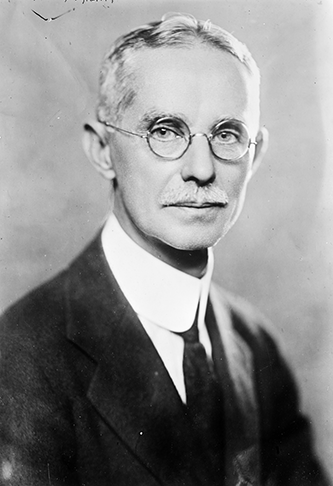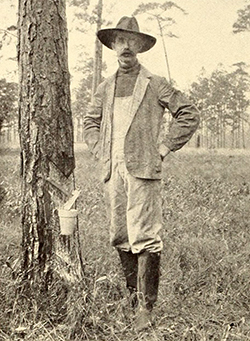Herty, Charles Holmes
4 Dec. 1867–27 July 1938
 Charles Holmes Herty, chemist, the son of Bernard and Louisa Turno Herty, was born in Milledgeville, Ga. He attended Middle Georgia Military and Agricultural College for four years before enrolling in the University of Georgia, where he received the Ph.B. degree in 1886. Four years later he was awarded a Ph.D. by Johns Hopkins University. During 1899 and 1900 he studied under Otto N. Witt at the University of Berlin and Alfred Werner at the University of Zurich.
Charles Holmes Herty, chemist, the son of Bernard and Louisa Turno Herty, was born in Milledgeville, Ga. He attended Middle Georgia Military and Agricultural College for four years before enrolling in the University of Georgia, where he received the Ph.B. degree in 1886. Four years later he was awarded a Ph.D. by Johns Hopkins University. During 1899 and 1900 he studied under Otto N. Witt at the University of Berlin and Alfred Werner at the University of Zurich.
Herty's varied career was characterized by service to his state and to the South. He was an assistant to the state chemist of North Carolina in 1888, and served in the same capacity at the Georgia Agricultural Experiment Station in Athens in 1890–91. From 1891 to 1902 he taught at the University of Georgia and from 1905 to 1916 at The University of North Carolina, where he was Smith Professor of General and Industrial Chemistry, dean of the School of Applied Science (1908–11), and a member of the athletics committee. At both schools he stressed the importance of applied chemistry as a solution to the South's economic problems.
While working for the U.S. Forestry Bureau from 1902 to 1904, Herty designed a cup-and-gutter method for collecting rosin from pine trees. His new technique replaced the old practice of collecting rosin from boxes cut into the base of the trees, thereby saving the turpentine industry millions of dollars. With grants from the Chemical Foundation, the state of Georgia, and the city of Savannah, Herty in 1931 began research in Savannah concerned with the production of rayon and paper from the cellulose and pulp of the southern pine tree. He successfully demonstrated that newsprint could be made from pine pulp, previously thought to be too resinous. This discovery stimulated the paper industry throughout the southern coastal region.
Herty attained a position of national prominence in his field, serving as president of the American Chemical Society for two terms (1915–16) and of the Synthetic Organic Chemical Manufacturers Association (1921–26), as well as editor of The Journal of Industrial and Engineering Chemistry (1917–21). From 1926 to 1928 he was adviser to the Chemical Foundation, and in 1928 he opened a consulting office in New York City. In addition to several separate publications, Herty wrote numerous articles for such periodicals as the Journal of the Elisha Mitchell Scientific Society, American Chemical Journal, Journal of the American Chemical Society, Journal of Industrial and Engineering Chemistry, and Science. His honors included an LL.D. degree awarded by The University of North Carolina (1933); degrees from the University of Florida, the University of Georgia, Duke University, Colgate University, the University of Pittsburgh, and Oglethorpe University; and the medal of the American Institute of Chemists (1932). On 17 Dec. 1946 a bronze memorial to Herty was unveiled at the Georgia capitol in Atlanta.
On 23 Dec. 1895, Herty married Sophie Schaller of Athens, Ga. They had three children: Charles Holmes, a metallurgist; Frank Bernard, a businessman; and Sophie Dorothea, a plant physiologist. An Episcopalian, Herty created while in Chapel Hill a retirement plan for clergy of the local parish; a system based on it was adopted by the entire denomination in 1917. He died in Savannah, and his cremated remains were buried in the old city cemetery in Milledgeville.
Atlanta Constitution, 18 Dec. 1946.
Frank K. Cameron, "Charles Holmes Herty, 1867–1938," Journal of the American Chemical Society 61 (1939).
DAB, vol. 9 (1958).
Milledgeville (Ga.) Times, 29 July 1938.
Raleigh News and Observer, 9 May 1932.
J. Maryon Saunders to Jaques Cattell, 23 June 1943 (Herty clipping file, North Carolina Collection, University of North Carolina Library, Chapel Hill).
University of North Carolina Catalogue (1905–17).
Additional Resources:
Reed, Germaine M. "Charles Herty (1867-1938)." The New Georgia Encyclopedia. 9/30/2005. http://www.georgiaencyclopedia.org/nge/Article.jsp?id=h-2607 (accessed July 3, 2013).
Paper Industry International Hall of Fame, Inc. "Charles Holmes Herty." Paper Industry Hall of Fame. http://www.paperhall.org/charlesherty/ (accessed July 3, 2013).
Hicks, Donald G. "Dr. Charles Holmes Herty (1867-1938) Perspectives on his career and life." ACS Georgia Local Section / Georgia State University. http://chemistry.gsu.edu/ACS/herty/HertyHist-DGH09.pdf (accessed July 3, 2013).
Reed, Gerry. "Saving the Naval Stores Industry: Charles Holmes Herty's Cup-and-Gutter Experiments 1900-1905." Journal of Forest History 26, no. 4 (October 1982), 168-175. http://www.jstor.org/stable/4004681 (accessed July 3, 2013).
Reed, Germaine M. "Charles Holmes Herty and the Establishment of Organized Athletics at the University of Georgia." The Georgia Historical Quarterly 77, no. 3 (Fall 1993). 525-540. http://www.jstor.org/stable/40582816 (accessed July 3, 2013).
"Charles Herty Birthplace State Historical Marker." GeorgiaInfo. Digital Library of Georgia. http://georgiainfo.galileo.usg.edu/gahistmarkers/hertybirthplacehistmarker.htm (accessed July 3, 2013).
"Pioneer Turpentining Experiment State Historical Marker." GeorgiaInfo. Digital Library of Georgia. http://georgiainfo.galileo.usg.edu/gahistmarkers/pioneerturpentinehistmarker.htm (accessed July 3, 2013).
Reed, Germaine M. Crusading for chemistry: the professional career of Charles Holmes Herty. Durham, N.C.: Forest History Society. 1995. http://dlg.galileo.usg.edu/ugapressbks/pdfs/ugp9780820335520.pdf (accessed July 3, 2013).
Charles H. Herty papers, 1860-1938. Manuscript, Archives, and Rare Book Library. Emory University. http://pid.emory.edu/ark:/25593/8zf9s (accessed July 3, 2013).
Image Credits:
Bain News Service. "Chas. H. Herty." Photograph. George Grantham Bain Collection. Prints and Photographs Division. Library of Congress. http://www.loc.gov/pictures/item/ggb2006007874/ (accessed July 3, 2013).
Charles Holmes Herty - Paper Industry International Hall of Fame. YouTube video, posted by PaperDiscoveryCenter, March 22, 2010. http://www.youtube.com/watch?v=b4iZLF9FXUc (accessed July 3, 2013).
"Dr. C.H. Herty of the University of N.C. His cup and gutter system of gathering turpentine increases the profits of the business $13,000,000 a year." The World's Work (Southern Number) 14, no. 2 (June 1907). 8968. https://archive.org/stream/worldswor1907unse#page/n93/mode/2up/search/herty (accessed July 3, 2013).
1 January 1988 | York, Maury
